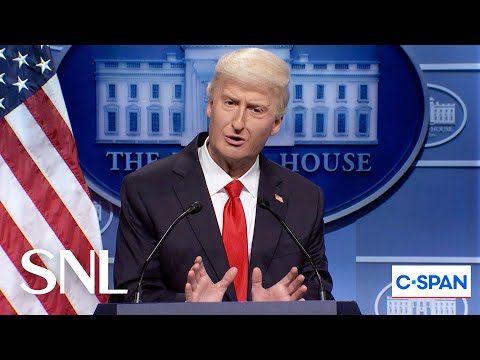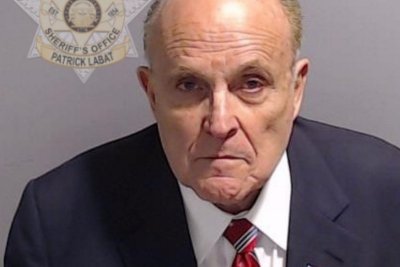Glen Powell charms on ‘SNL,’ MacGruber returns to destroy Epstein files
If you’ve seen some of Glen Powell’s movies, including “Top Gun: Maverick,” “Hit Man,” “Anyone But You” or “Twisters,” you probably already know that a large part of the actor’s appeal is that he goes down smooth and easy.
With good looks and lots of charm, he’s certainly leading man material. But there’s also a streak, particularly in his Richard Linklater film “Hit Man,” of a goofball comedy nerd dying to break out from that handsome shell (see also: Jon Hamm), even if he was there to promote a new action film, “The Running Man.”
It sure feels like that sensibility is what helped make for a remarkable episode of “Saturday Night Live” with Powell hosting for the first time. It was the silliest episode so far this season, and by some miracle, just about every sketch in the episode worked, at least on a basic comedic level.
Powell wore wigs, most notably in a military sketch about bobs versus bangs; yes, the hairstyles. He did Norwegian and Irish accents in respective sketches about overenthusiastic actors in a Nordic film and one modeled after Liam Neeson’s “Taken” films. He even wore a long ponytail and sang in a pre-recorded musical number about men who miss their ex-girlfriend’s dad (Powell was one of the dads). But he was also a great supporting player to Marcello Hernández in a sketch about comedian Sebatian Maniscalco at a bachelor party and one about a woman (Ashley Padilla) who joins friends at a restaurant after a disastrous hair salon visit. And he did some good silent acting in a visual gag-driven sketch in which AI technology brings old photos to life badly.
It was a week where even the return of former cast member Will Forte, who appeared in three new MacGruber sketches where the character finds out he’s in the Epstein files (explosions follow), didn’t fully overshadow a lot of other very good pieces.
Two quick notes about this week’s episode: Padilla continues to help anchor the show with excellent sketch performances, this time as the hair styling victim, a shocked grandmother in a nursing home and as White House Press Secretary Karoline Leavitt in the cold open. As each episode goes by with Padilla billed as a featured player instead of a full cast member, it feels like a mistake that’s growing.
Second, this was the first time in years that “Weekend Update” had no guest segments. We’ll get to that in a bit.
Musical guest Olivia Dean performed “Man I Need” and “Let Alone the One You Love.”

President Trump (James Austin Johnson) cold opens are getting to be a mixed blessing; the impression is still solid, and the president is certainly in the news enough to warrant addressing every week. But the format of the sketch, beginning with the premise of the news of the week and then being interrupted by a meta Trump monologue, feels reflexive at this point, the easy answer for wrapping up increasingly disjointed and weird news cycles. At the White House, Leavitt downplays news of the release of Jeffery Epstein’s emails, defending the president as, “loving too much and possibly too young.” When a reporter asks about millions of dollars being sent to Argentina, she tries to turn attention back to the files, which leads to Trump appearing and asking questions such as, “If there were something incriminating in the files, why would I cover them up?” and “If I were innocent, wouldn’t I just release the files?” The president offers to sell framed copies of the Epstein emails at $800 a pop. The rambling defense leads to a Trump Multiverse Theory, which posits that Trump exists across many timelines and we happen to live in the worst one.

In Powell’s monologue, the actor admits he’s been so publicized that even he’s tired of seeing his own face. “You know who is not tired of seeing my face?” he asked. “Your mom.” Powell pushed back against the narrative that he was an overnight success; he’s been acting since he was 10, starting with commercials and safety videos, while growing up in Austin, Texas. Powell revealed that he was supposed to host “SNL” four years ago as part of the publicity tour for “Top Gun: Maverick.” But when the movie was delayed because of the COVID-19 pandemic, the offer was put on hold. A UPS driver who showed up when Powell was celebrating the initial news about hosting “SNL” ended up in a selfie with the actor and his family. Powell said his sisters tracked down the driver and Powell invited him to come see the show. Thus, Mitch the UPS Driver appeared in the monologue and again at the end of the show for the goodnights. Glen ended the monologue saying, “The best things in life don’t happen overnight. No one knows that better than UPS.”
Best sketch of the night: AI has not advanced enough to get crotches right

A family is visiting their grandmother for Thanksgiving at an assisted-living facility and as a treat, they’ve used an app to animate some of her old black-and-white photos using artificial intelligence. But the AI can only imagine so much; it brings to life a dog with tails on both ends instead of a head, an old family friend who takes off his pants to reveal a Ken doll-like crotch (Mikey Day) and a horrifying baby that folds like an accordion as an atom bomb goes off in the background. Padilla’s reactions and the silent comedy from Day and Powell take this sketch over the top.
Also good: Of course MacGruber is in the Epstein files, how could he not be?

It’s always nice to see Will Forte back on “SNL,” and this time he brought back his most popular character for three short video segments continuing the story of MacGruber, the tech wiz who always ends up failing to disarm a ticking time bomb. This time, the clock is ticking as MacGruber’s companions (Powell and Chloe Fineman) figure out that MacGruber is in the Epstein files. Their first clue? Just after thumbing through a copy, he immediately tries to shred the entire document. Over three sketches, MacGruber stalls, deflects, then eventually decides to testify against those who actually engaged in behavior worse than his on Epstein’s island — until he finds out he could get paid lots of money to keep quiet. Cut to the sketch-ending explosion.
‘Weekend Update’ winner: No guest segment, but two very funny bits

Usually on “Weekend Update,” cast members such as Bowen Yang or guests come on to do a few minutes as a character or as themselves. This week, there apparently wasn’t time for that, so “Update” was nothing but Colin Jost and Michael Che jokes. There were two that stood out, however. One was about a salacious rumor involving Trump and former President Bill Clinton that’s very difficult to discuss in detail in this space. A video that ended up with a very obviously spliced piece of audio as a punchline went over so well Jost had to stop to collect himself from laughing so hard. The other was a great, simple joke about the U.S. Mint ending production of pennies. “Makes no cents!” Che exclaimed. Nice one, Che.




